Bem-vindo ao nosso guia abrangente sobre Gás inerte para fusão por indução de eletrodos (EIMIG), uma técnica sofisticada usada na produção de pós metálicos de alta qualidade. Seja você um engenheiro de materiais, um pesquisador ou simplesmente um curioso sobre processos metalúrgicos avançados, este artigo foi elaborado para fornecer uma compreensão detalhada da EIMIG. Vamos nos aprofundar em sua mecânica, explorar modelos específicos de pós metálicos e destacar suas diversas aplicações. Então, vamos começar!
Visão geral da fusão por indução com eletrodo de gás inerte
A fusão por indução de eletrodos com gás inerte (EIMIG) é um processo metalúrgico de ponta que envolve a fusão de metais usando um arco elétrico gerado entre eletrodos em um ambiente de gás inerte. Esse método é particularmente vantajoso para a produção de pós metálicos de alta pureza, que são essenciais em setores que vão desde a indústria aeroespacial até a engenharia biomédica.
O que torna a EIMIG especial?
A EIMIG se destaca por sua capacidade de produzir pós metálicos com pureza superior e tamanhos de partículas controlados. Ao usar uma atmosfera de gás inerte, normalmente argônio ou hélio, a oxidação e a contaminação são minimizadas, garantindo a produção de pós metálicos de alta qualidade. O processo também é altamente versátil, permitindo a fusão de uma ampla variedade de metais e ligas.
Componentes principais da EIMIG
- Eletrodos: Geralmente feitos de grafite ou tungstênio, geram o arco elétrico necessário para a fusão.
- Ambiente de gás inerte: Argônio ou hélio são comumente usados para evitar a oxidação.
- Sistema de aquecimento por indução: Fornece a energia necessária para sustentar o processo de fusão.
- Cadinho: Mantém o metal enquanto ele derrete e esfria em forma de pó.

Tipos de pós metálicos produzidos pela EIMIG
A EIMIG pode produzir uma variedade de pós metálicos, cada um com propriedades exclusivas adequadas para diferentes aplicações. Aqui estão dez modelos específicos:
1. Liga de titânio (Ti-6Al-4V)
Composição: Titânio, alumínio, vanádio
Propriedades: Alta relação resistência/peso, excelente resistência à corrosão
Formulários: Componentes aeroespaciais, implantes médicos
2. Superliga de níquel (Inconel 718)
Composição: Níquel, cromo, ferro, nióbio
Propriedades: Resistência a altas temperaturas, excelentes propriedades mecânicas
Formulários: Lâminas de turbina, motores a jato
3. Aço inoxidável (316L)
Composição: Ferro, cromo, níquel, molibdênio
Propriedades: Alta resistência à corrosão, boa conformabilidade
Formulários: Dispositivos biomédicos, equipamentos de processamento de alimentos
4. Liga de cobalto-cromo (Co-Cr-Mo)
Composição: Cobalto, cromo, molibdênio
Propriedades: Alta resistência ao desgaste, biocompatibilidade
Formulários: Implantes dentários, implantes ortopédicos
5. Liga de alumínio (AlSi10Mg)
Composição: Alumínio, silício, magnésio
Propriedades: Leve, boa condutividade térmica
Formulários: Peças automotivas, estruturas aeroespaciais
6. Liga de cobre (CuNi2SiCr)
Composição: Cobre, níquel, silício, cromo
Propriedades: Alta condutividade elétrica, boa resistência mecânica
Formulários: Conectores elétricos, trocadores de calor
7. Aço ferramenta (H13)
Composição: Ferro, cromo, molibdênio, vanádio
Propriedades: Alta tenacidade, excelente resistência ao calor
Formulários: Moldes para fundição sob pressão, ferramentas de extrusão
8. Aço Maraging (18Ni300)
Composição: Ferro, níquel, cobalto, molibdênio
Propriedades: Alta resistência, boa tenacidade
Formulários: Componentes aeroespaciais, ferramentas
9. Carbeto de tungstênio (WC-Co)
Composição: Tungstênio, Cobalto
Propriedades: Extremamente duro, alta resistência ao desgaste
Formulários: Ferramentas de corte, equipamentos de mineração
10. Liga de zircônio (Zr702)
Composição: Zircônio, háfnio, ferro
Propriedades: Excelente resistência à corrosão, boas propriedades mecânicas
Formulários: Reatores nucleares, equipamentos de processamento químico
Características de Gás inerte para fusão por indução de eletrodos
A EIMIG é conhecida por várias características importantes que a tornam uma opção atraente para a produção de pós metálicos.
Pureza
O ambiente de gás inerte reduz significativamente a contaminação, resultando em pós metálicos com altos níveis de pureza.
Controle de tamanho de partícula
A EIMIG permite o controle preciso da distribuição do tamanho das partículas, o que é crucial para aplicações que exigem características específicas do pó.
Versatilidade
O processo é adaptável a uma ampla gama de metais e ligas, o que o torna adequado para diversas aplicações industriais.
Eficiência
A EIMIG é um processo eficiente em termos de energia, capaz de produzir altos rendimentos de pó metálico com o mínimo de resíduos.
Aplicações da fusão por indução com eletrodo de gás inerte
Os pós metálicos produzidos pela EIMIG são utilizados em vários setores de alta tecnologia devido às suas propriedades superiores.
Indústria aeroespacial
Ligas leves e de alta resistência, como o Ti-6Al-4V, são essenciais para componentes de aeronaves, onde o desempenho e a confiabilidade são fundamentais.
Engenharia Biomédica
Materiais biocompatíveis, como o Co-Cr-Mo, são usados em implantes e dispositivos médicos, garantindo segurança e eficácia para os pacientes.
Setor automotivo
As ligas de alumínio, como AlSi10Mg, são usadas em peças automotivas para reduzir o peso e melhorar a eficiência do combustível.
Eletrônicos
As ligas de cobre com alta condutividade elétrica são essenciais para conectores e outros componentes eletrônicos.
Ferramentas e fabricação
Os aços para ferramentas e os pós de carboneto de tungstênio são usados para criar moldes e ferramentas de corte duráveis para vários processos de fabricação.
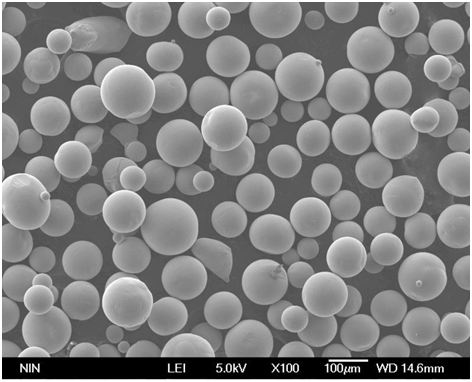
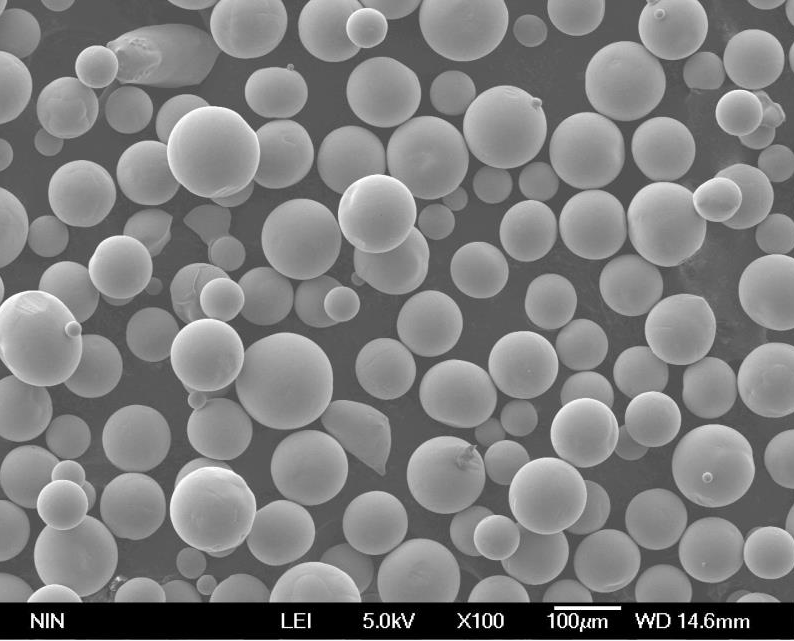
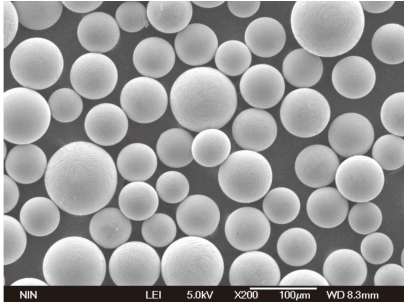


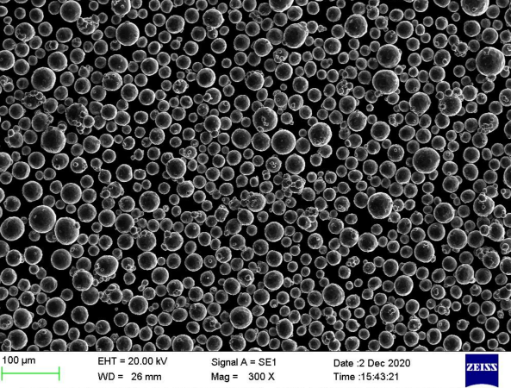
Especificações detalhadas dos pós metálicos da EIMIG
Propriedades e características
| Pó metálico | Densidade (g/cm³) | Ponto de fusão (°C) | Dureza (HV) | Resistência à tração (MPa) | Alongamento (%) |
|---|---|---|---|---|---|
| Ti-6Al-4V | 4.43 | 1660 | 349 | 895 | 10 |
| Inconel 718 | 8.19 | 1350 | 330 | 1240 | 12 |
| Aço inoxidável 316L | 7.99 | 1375 | 217 | 620 | 40 |
| Co-Cr-Mo | 8.29 | 1330 | 450 | 900 | 8 |
| AlSi10Mg | 2.68 | 570 | 85 | 310 | 7 |
| CuNi2SiCr | 8.78 | 1083 | 100 | 450 | 20 |
| Aço para ferramentas H13 | 7.80 | 1427 | 750 | 1450 | 12 |
| aço Maraging 18Ni300 | 8.00 | 1413 | 340 | 2000 | 10 |
| WC-Co | 15.60 | 2870 | 1600 | – | – |
| Zr702 | 6.50 | 1855 | 250 | 550 | 30 |
Aplicações e usos
| Pó metálico | Aplicativos primários | Usos adicionais |
|---|---|---|
| Ti-6Al-4V | Componentes aeroespaciais, implantes médicos | Artigos esportivos, aplicações marítimas |
| Inconel 718 | Lâminas de turbina, motores a jato | Reatores nucleares, veículos espaciais |
| Aço inoxidável 316L | Dispositivos biomédicos, processamento de alimentos | Processamento químico, aplicações marítimas |
| Co-Cr-Mo | Implantes dentários, implantes ortopédicos | Componentes de relógios, rolamentos industriais |
| AlSi10Mg | Peças automotivas, estruturas aeroespaciais | Eletrônicos de consumo, bicicletas |
| CuNi2SiCr | Conectores elétricos, trocadores de calor | Aplicações marítimas, cunhagem |
| Aço para ferramentas H13 | Moldes para fundição sob pressão, ferramentas de extrusão | Moldes de injeção, matrizes de forjamento |
| aço Maraging 18Ni300 | Componentes aeroespaciais, ferramentas | Engrenagens e eixos de alto desempenho |
| WC-Co | Ferramentas de corte, equipamentos de mineração | Peças resistentes ao desgaste, ferramentas de perfuração |
| Zr702 | Reatores nucleares, processamento químico | Dispositivos médicos, componentes aeroespaciais |
Especificações, tamanhos, graus, padrões
| Pó metálico | Grau | Faixa de tamanho (µm) | Padrão |
|---|---|---|---|
| Ti-6Al-4V | Grau 5 | 15-45 | ASTM B348 |
| Inconel 718 | UNS N07718 | 15-53 | AMS 5662 |
| Aço inoxidável 316L | 316L | 10-45 | ASTM F138 |
| Co-Cr-Mo | ASTM F75 | 20-63 | ISO 5832-4 |
| AlSi10Mg | – | 15-45 | DIN EN 1706 |
| CuNi2SiCr | – | 20-50 | ASTM B422 |
| Aço para ferramentas H13 | H13 | 20-63 | ASTM A681 |
| aço Maraging 18Ni300 | 18Ni300 | 10-45 | AMS 6514 |
| WC-Co | 1-20 | ISO 4499-1 | |
| Zr702 | R60702 | 15-45 | ASTM B551 |
Detalhes de fornecedores e preços
| Fornecedor | Pó metálico | Preço (por kg) | Disponibilidade |
|---|---|---|---|
| Advanced Powders Inc. | Ti-6Al-4V | $150 | Em estoque |
| Specialty Metals Co. | Inconel 718 | $200 | Estoque limitado |
| Materiais médicos LLC | Aço inoxidável 316L | $120 | Em estoque |
| BioMetals Corp. | Co-Cr-Mo | $180 | Pré-encomenda obrigatória |
| Light Metals Inc. | AlSi10Mg | $100 | Em estoque |
| Electrical Alloys Ltd. | CuNi2SiCr | $160 | Em estoque |
| Tool Steel Supply Co. | Aço para ferramentas H13 | $140 | Estoque limitado |
| Metais de alta resistência | aço Maraging 18Ni300 | $220 | Em estoque |
| Grupo de Metais Duros | WC-Co | $300 | Pré-encomenda obrigatória |
| Nuclear Materials Inc. | Zr702 | $250 | Em estoque |
Comparação de prós e contras, vantagens e limitações
| Pó metálico | Vantagens | Limitações |
|---|---|---|
| Ti-6Al-4V | Alta resistência, leveza e resistência à corrosão | Caro, difícil de usinar |
| Inconel 718 | Excelentes propriedades para altas temperaturas | Alto custo, processamento complexo |
| Aço inoxidável 316L | Resistente à corrosão, biocompatível | Menor resistência em comparação com outras ligas |
| Co-Cr-Mo | Alta resistência ao desgaste, biocompatibilidade | Fragilidade, caro |
| AlSi10Mg | Leve, com boas propriedades térmicas | Menor resistência em comparação com as ligas de aço |
| CuNi2SiCr | Alta condutividade elétrica, resistente à corrosão | Caro, resistência mecânica limitada |
| Aço para ferramentas H13 | Alta tenacidade, resistência ao calor | Suscetível a rachaduras sob tensão |
| aço Maraging 18Ni300 | Alta resistência, boa tenacidade | Necessidade de tratamento térmico caro e complexo |
| WC-Co | Extremamente duro, com alta resistência ao desgaste | Fragilidade, alto custo |
| Zr702 | Excelente resistência à corrosão, boas propriedades mecânicas | Alto custo, disponibilidade limitada |
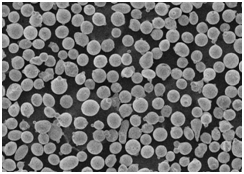
perguntas frequentes
O que é Gás inerte para fusão por indução de eletrodos (EIMIG)?
A EIMIG é um processo em que os metais são fundidos por meio de um arco elétrico entre eletrodos em uma atmosfera de gás inerte, produzindo pós metálicos de alta pureza.
Por que usar um gás inerte na EIMIG?
Gases inertes, como argônio ou hélio, evitam a oxidação e a contaminação durante o processo de fusão, garantindo pós metálicos de alta qualidade.
Quais metais podem ser fundidos com a EIMIG?
A EIMIG é versátil e pode fundir uma ampla variedade de metais e ligas, incluindo titânio, níquel, aço inoxidável, cobalto-cromo e muito mais.
Quais são as aplicações dos pós metálicos EIMIG?
Os pós metálicos EIMIG são usados nos setores aeroespacial, de engenharia biomédica, automotivo, eletrônico e de ferramentas devido às suas propriedades superiores.
Como a EIMIG controla o tamanho das partículas?
Os parâmetros do processo no EIMIG podem ser ajustados com precisão para controlar a distribuição do tamanho das partículas, garantindo a consistência e a precisão do produto final.
Os pós metálicos da EIMIG são caros?
O custo dos pós metálicos EIMIG varia de acordo com o tipo e a pureza do metal, mas geralmente tende a ser mais alto devido à natureza avançada do processo.
Quais são os principais benefícios da EIMIG?
A EIMIG oferece alta pureza, controle preciso do tamanho das partículas, versatilidade nos tipos de metal e produção eficiente, o que a torna altamente vantajosa para a produção de pós metálicos especializados.
Como a EIMIG é diferente de outras técnicas de fusão?
A EIMIG utiliza uma atmosfera de gás inerte e aquecimento por indução, o que reduz a contaminação e permite o controle preciso do processo de fusão, diferenciando-a de outras técnicas, como a fusão por arco convencional.
A EIMIG pode ser usada para produção em larga escala?
Sim, a EIMIG pode ser ampliada para produção industrial, o que a torna adequada tanto para pesquisa em pequena escala quanto para fabricação em grande escala.
Quem são os principais fornecedores de pós metálicos EIMIG?
Os principais fornecedores incluem Advanced Powders Inc., Specialty Metals Co., Medical Materials LLC e BioMetals Corp., entre outros, que oferecem uma variedade de pós metálicos para diferentes aplicações.
Conclusão
A fusão por indução de eletrodo com gás inerte (EIMIG) é uma tecnologia transformadora no campo da metalurgia, oferecendo pureza e precisão inigualáveis na produção de pó metálico. Suas aplicações abrangem setores críticos, garantindo alto desempenho e confiabilidade em ambientes exigentes. Não importa se você está procurando componentes aeroespaciais, dispositivos biomédicos ou ferramentas de alto desempenho, o EIMIG fornece os materiais avançados necessários para ampliar os limites da inovação.

